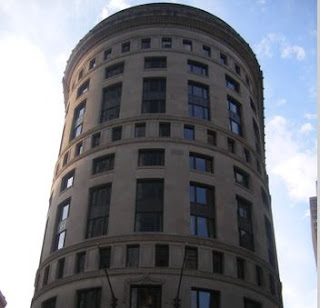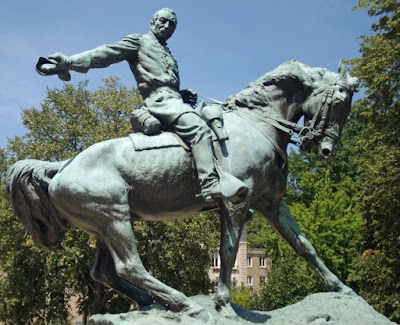Free Walking Tours NYC : William Tecumseh Sherman Statue - GrandArmyPlaza in New York City’s Central Park received its most iconic marker, the Sherman equestrian statue, on Memorial Day 1903. The sculpture features Sherman astride his horse with its right hoof slightly raised. The horse’s rear hoofs are orchestrated atop a series of Georgian pine, a subtle reference to the Sherman’s famed March to the Sea. Leading Sherman is a winged figure with a large palm frond in her left hand while her right arm is extended as if pointing the way to “Victory” for the General. The statue has been ornately covered in a gold leaf that adds to the sculpture’s brilliance. When the sculpture was being constructed, its designer Augustus Saint-Gaudens mandated that the work be covered in two layers of gold to ensure the statue maintained its skin and did not take on a “smoke stack” appearance.
Saint-Gaudens was commissioned to create the sculpture of Sherman in 1892 shortly after the General’s death the year prior. Already a noted artist for his creations of the Diana statue that formerly resided atop Madison Square Garden and the Robert Gould Shaw Memorial within the Boston Common, he was known for both his elegance and perfectionism that led to the works being unveiled a bit less timely than most artists. For instance, Saint-Gaudens spent fourteen years working on the Robert Gould Shaw Memorial before he deemed it complete. Fortunately park officials only had to wait eleven years for the unveiling of the Sherman statue.
To create a likeness of Sherman, Saint-Gaudens leveraged a prior bust he had created by the General in 1888. While sculpting the bust, Sherman posed for eighteen two-hour sessions for the artist to ensure he accurately captured the man’s image. During one, especially lengthy session, it was reported that Saint-Gaudens instructed Sherman to re-button his shirt collar which had become disheveled. Sherman retorted back to the artist that, “The General of the Army of the United States will wear his coat any damn way he pleases.”
Saint-Gaudens used another model as his inspiration for the image of the winged “Victory”. Harriette (“Hettie”) Eugenia Anderson was an African-American model whose image Saint-Gaudens also captured in his design of the Indian Head eagle coin that was minted between 1907 and 1916.
During his eleven years of laboring over the sculpture, Saint-Gaudens became ill and his presence at the unveiling was documented as being quite frail. Unfortunately the Sherman Memorial would be Saint-Gaudens’ last significant work as he passed away four years later in 1907.
Thanks in part to Saint-Gaudens’ obsessive request to ensure two layers of gold leaf on the Sherman Memorial, it maintained its glamour longer than many sculptures. By 1989, however, the statue had started to show signs of wear and tear and the monument was restored.
As to the man himself, Sherman was born William Tecumseh Sherman on February 8, 1820. His unique middle name has long been a source of speculation as to its derivation. Various accounts have been reported over the years. Sherman himself claimed his father suggested the name in honor of the great Shawnee leader who had attempted to unite the tribes in the Ohio Valley versus Americans encroaching on their lands. Other accounts, such as the one published in a 1932 biography, claim that Tecumseh was not even Sherman’s middle name but his first. The biography states that “William” was first given to him as a good Christian name later in life at the age of nine or ten by his then foster mother, Maria Ewing.
At the age of sixteen Sherman enrolled in the United States Military Academy at West Point. Although he would later be declared the first “modern” general and become recognized for his efforts in ending the Civil War, Sherman was not always considered prime cadet material. Sherman recalled, “At the Academy (West Point) I was not considered a good soldier, for at no time was I selected for any office, but remained a private throughout the whole four years.”
Sherman proved his worth over the course of the Civil War, though in key battles such as Bull Run and Shiloh. His tenacity made him a natural leader that led others to follow. His resolve was demonstrated for instance, in the Battle of Shiloh where, despite having three horses shot out from under him and being wounded on two separate occasions (in the hand and shoulder), he continued his pursuit of the enemy. Sherman’s success would lead him to being promoted to major general in 1862.
Perhaps Sherman’s most noted encounter during the Civil War was his infamous March to the Sea in November 1864. After capturing the city of Atlanta for the Union army his troops set fire to the city. Sherman later stated that he never intended for the complete destruction of Atlanta as occurred, since he only instructed his troops to burn munitions factories and other resources of the Confederate army. By the time all was said and done, though, Sherman and his troops had left a trail of destruction that measured sixty miles between Atlanta and Savannah. Although criticized as being inhumane by some, the tactics used had the effect of requiring Confederate troops to scatter and led to their surrender shortly thereafter.
Upon conclusion of the war, Sherman retired to a townhouse on West 71st Street in New York City. He would often spend his time in retirement riding his horse in Central Park. When not riding, Sherman also began work on his personal Memoirs which were published in 1875. These Memoirs are considered one of the best historical accounts of the Civil War. Accepting an invite to share his personal accounts to the graduate class of the Michigan Military Academy in 1879, Sherman explained to students that “War is hell.” His usage of the phrase is the first documented account of an expression that would grace many a politician and soldier’s lips in the years to come. Sherman remained in New York City for the remainder of his days. The general passed away at the age of seventy-one in 1891.
Saint-Gaudens was commissioned to create the sculpture of Sherman in 1892 shortly after the General’s death the year prior. Already a noted artist for his creations of the Diana statue that formerly resided atop Madison Square Garden and the Robert Gould Shaw Memorial within the Boston Common, he was known for both his elegance and perfectionism that led to the works being unveiled a bit less timely than most artists. For instance, Saint-Gaudens spent fourteen years working on the Robert Gould Shaw Memorial before he deemed it complete. Fortunately park officials only had to wait eleven years for the unveiling of the Sherman statue.
To create a likeness of Sherman, Saint-Gaudens leveraged a prior bust he had created by the General in 1888. While sculpting the bust, Sherman posed for eighteen two-hour sessions for the artist to ensure he accurately captured the man’s image. During one, especially lengthy session, it was reported that Saint-Gaudens instructed Sherman to re-button his shirt collar which had become disheveled. Sherman retorted back to the artist that, “The General of the Army of the United States will wear his coat any damn way he pleases.”
Saint-Gaudens used another model as his inspiration for the image of the winged “Victory”. Harriette (“Hettie”) Eugenia Anderson was an African-American model whose image Saint-Gaudens also captured in his design of the Indian Head eagle coin that was minted between 1907 and 1916.
During his eleven years of laboring over the sculpture, Saint-Gaudens became ill and his presence at the unveiling was documented as being quite frail. Unfortunately the Sherman Memorial would be Saint-Gaudens’ last significant work as he passed away four years later in 1907.
Thanks in part to Saint-Gaudens’ obsessive request to ensure two layers of gold leaf on the Sherman Memorial, it maintained its glamour longer than many sculptures. By 1989, however, the statue had started to show signs of wear and tear and the monument was restored.
As to the man himself, Sherman was born William Tecumseh Sherman on February 8, 1820. His unique middle name has long been a source of speculation as to its derivation. Various accounts have been reported over the years. Sherman himself claimed his father suggested the name in honor of the great Shawnee leader who had attempted to unite the tribes in the Ohio Valley versus Americans encroaching on their lands. Other accounts, such as the one published in a 1932 biography, claim that Tecumseh was not even Sherman’s middle name but his first. The biography states that “William” was first given to him as a good Christian name later in life at the age of nine or ten by his then foster mother, Maria Ewing.
At the age of sixteen Sherman enrolled in the United States Military Academy at West Point. Although he would later be declared the first “modern” general and become recognized for his efforts in ending the Civil War, Sherman was not always considered prime cadet material. Sherman recalled, “At the Academy (West Point) I was not considered a good soldier, for at no time was I selected for any office, but remained a private throughout the whole four years.”
 |
| William Tecumseh Sherman Statue |
Perhaps Sherman’s most noted encounter during the Civil War was his infamous March to the Sea in November 1864. After capturing the city of Atlanta for the Union army his troops set fire to the city. Sherman later stated that he never intended for the complete destruction of Atlanta as occurred, since he only instructed his troops to burn munitions factories and other resources of the Confederate army. By the time all was said and done, though, Sherman and his troops had left a trail of destruction that measured sixty miles between Atlanta and Savannah. Although criticized as being inhumane by some, the tactics used had the effect of requiring Confederate troops to scatter and led to their surrender shortly thereafter.
Upon conclusion of the war, Sherman retired to a townhouse on West 71st Street in New York City. He would often spend his time in retirement riding his horse in Central Park. When not riding, Sherman also began work on his personal Memoirs which were published in 1875. These Memoirs are considered one of the best historical accounts of the Civil War. Accepting an invite to share his personal accounts to the graduate class of the Michigan Military Academy in 1879, Sherman explained to students that “War is hell.” His usage of the phrase is the first documented account of an expression that would grace many a politician and soldier’s lips in the years to come. Sherman remained in New York City for the remainder of his days. The general passed away at the age of seventy-one in 1891.
- Website: http://www.centralparknyc.org/visit/things-to-see/south-end/william-tecumseh-sherman-grand-army-plaza.html
- Address: Central Park, New York City, NY (Grand Army Plaza, Intersection of Central Park South and Fifth Avenue)
- Cost: Free























